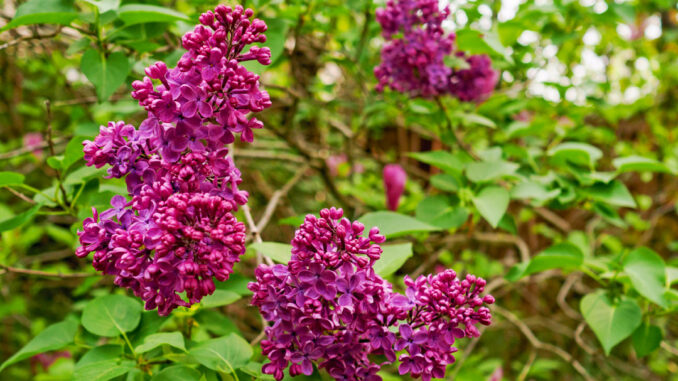
Welcome home to a spring garden already on its own blooming schedule. In this impatient season, you can count on the earliest spring flowers from deeply scented hyacinth lilacs. But don’t rush the roses with too much love and fertilizer.
Early-blooming lilacs
While waiting patiently for roses to put out their first blossoms, there’s an opportunity to be instantly gratified by the romantic and heavily fragranced flowers of hyacinth lilacs (Syringa hyacinthiflora), the earliest lilacs to bloom in our northern climate. The many French and Canadian hybrids in this early category have generous trusses of single or double blossoms with a classic lilac scent that is delightfully carried by chilled spring breezes. The shrubs grow tall (eight to 10 feet), with upright structure and little suckering, and bloom reliably every year. Their vase-like form makes them ideal for filling corners or framing a wide view. The smooth, heart-shaped leaves have ornamental value, turning bronze and burgundy in autumn. Hyacinth lilacs should be allowed to assume their height with only light pruning for shape and dead twig removal.
Hyacinth lilacs are also simply known as early lilacs, and some named hybrids to look for are ‘Pocohontas’ (burgundy buds, single bluish-purple flowers), ‘Maiden’s Blush’ (single blush-pink flowers, heavy fragrance), ‘Royal Purple’ (double deep-purple flowers with blue centres, two-tone effect), ‘Swarthmore’ (pink buds, double mauve flowers streaked white), ‘Mount Baker’ (single white, heavy bloomer). There is a long list of named early-blooming hyacinth lilacs, and it’s worth visiting a selection of local plant centres to see what named hybrids are on offer this season.
The hyacinth lilacs are cold hardy and disease resistant and are easily grown in common garden soil that drains adequately in all seasons. Like any plant that carries large numbers of floral petals, they appreciate regular watering all through the growing season. They bloom most prolifically in full sun locations and with fewer hours of direct sunlight, the number of blooms will be reduced. But no matter how many flowers open in early spring, the scent alone is enough reason to keep them in your personal landscape.
Roses in spring
At the first hint of longer daylight hours and milder weather, rose growers are out in the garden examining the state of their roses shrubs that have come through a long, cold season. First consideration is sorting out the living green canes from others that are shades of tan to brown, indicating dead wood. If canes appear dead, cutting off small sections starting at the tips will show what’s going on inside the cane. Continue cutting off short lengths and, hopefully, living wood will be reached. But sometimes, the whole cane is dead and needs to be removed entirely. Finally, remove any cane or shot too thin to support the weight of flowers.
Roses benefit from spring renewal of a two-inch thick mulch of organic material such as homemade compost, leaves and shredded bark laid over their roots, allowing six inches of soil around the shrub’s crown to be bare and exposed. The mulch will help keep soil in the root zone cool in summer heat and preserve moisture.
Now comes the crucial question of what and when to feed roses. If canes are still bare with no foliage present, the directions are simple – do not feed. Leaves are the energy production factory for nutrients sent up from the roots. Without foliage to process nutrients, the shrub can be overwhelmed by a big fertilizer meal and suffer root loss. New roots will need to be grown before the shrub can resume its blooming preparations. Rose shrubs usually survive spring fertilizer shock, but cane and bud development will be slowed. Hold back on feeding until the rose shrubs develop two or three sets of leaves before giving them fertilizer that will stimulate growth.
When two to three sets of new leaves appear, it will be time for spring feeding. Roses respond best to moderately low levels of fertilizer. It’s always better to select fertilizer products with lower numbers (preferably all below 12) in the nutrient analysis printed on the package.
Plant foods are divided into two categories – fertilizer products primarily supplying basic nitrogen, phosphorus and potassium; and similar fertilizers labeled organic and made from materials such as cattle manure, feather meal, chicken and turkey litter, bat guano (approximately 7% nitrogen), processed fish and bloodmeal (approximately 10% nitrogen). All of these fertilizers are beneficial to roses in spring if their nutrient analysis is appropriately low.
A second group of plant foods is known as growth enhancers. These are organic plant materials that carry natural hormones and complex micro-nutrients influencing the color saturation and scent of rose petals, as well as strengthening the full health of the shrub. The most readily available growth enhancers are products derived from kelp seaweed (sold as liquid concentrate and also in dry meal form) and alfalfa (available as dry pellets that should be dug into soil).
Holding back on fertilizing too early, waiting for the first leaves to appear and then applying a moderately rich fertilizer will set roses up for a summer of high production. Apply a subsequent fertilizer meal after each flush of roses is mostly finished (but still carrying some open blossoms), being sure to trim off finished flowers to prevent seed formation. The shrub will use these nutrients and begin making buds for the next round of blooms. Subsequent feedings can follow each blooming cycle, up to late summer.


